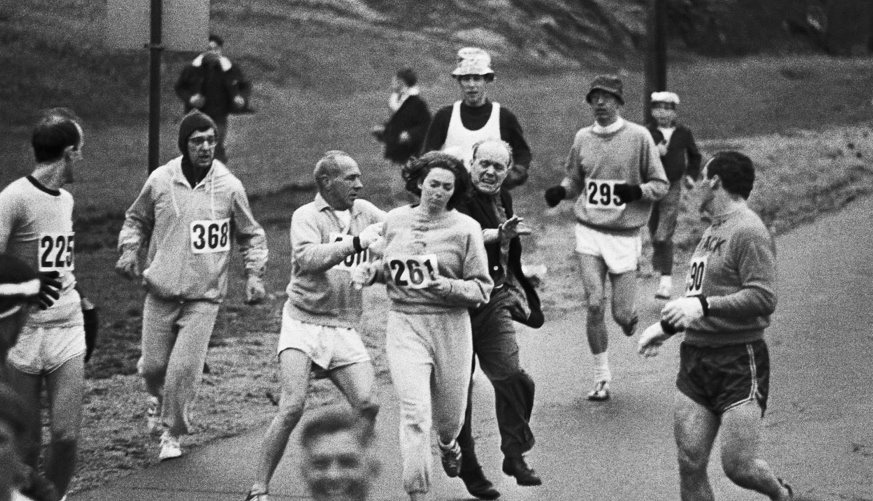In 1967 no one thought that a woman was capable of running more than 42 kilometers nor running a Marathon. The famous Boston Marathon, for 70 years, had been an event exclusively for men.
“No dame ever ran the Boston Marathon!” told Arnie, the trainer of Kathrine Switzer. But Kathrine knew that she could do it, that she wanted to do it. And even though the words of someone close to her hurt and the society’s principles were against her, she got ready to run and became a key participant of a change in the history of women’s athletics.
Kathrine began its training 3 months before running for the Marathon of Boston celebrated in 1967. When it was time to register for the race, Kathrine, her coach and boyfriend, who had decided to take part in the race with her, were assaulted by doubts and fear. No woman had previously participated in the Boston Marathon, and they didn’t know if it was legal or not, since in the race’s regulations nothing was written about women. But she had a dream and didn’t want to give it up. She didn´t want any unwritten social norms to take her away from that dream, so she decided to sign up for the race by signing with her initials K. V. Switzer.
To jump into the lion´s den
The day the Boston Marathon started, she didn’t know if they would let her run the race or if they would throw her out of it. Fortunately, her sweatshirt and long sweatpants helped her cover up herself among the rest of the competitors, but she still had to sign up for her identification number.
“I held up the big outer sweatshirt so they could check my number and the official put his hand on my shoulder and gently shoved me forward, saying, “C’mon runners, let’s move on in, just keep it moving here!”. And that’s how she worked her way into the back of the field.
At the beginning, she was accompanied by her coach and her boyfriend, but she noticed something strange. She realized that the rest of the runners were looking at her recognizing she was a woman. Far from bothering, discriminating her or being surprised to have a woman among them, they wished her luck. According to Kathrine, they were happy to see her running along with them. The race, considered at that time as Mecca for runners, started in this positive atmosphere.
She didn’t fear the physical and mental effort of facing a race of more than 42 kilometers, since, according to her, she did not feel tired.
But this is when occurred an event that would last forever in the history of athletics, women’s sport and society.
A press bus documenting the race happened filming the competitors. One of the race officials on the bus, Jock Semple, recognized Kathrine and ran after her, trying to grab her, he pushed her and shouted out loud “Get the hell out of my race and give me that number!”. Her coach, Arnie, started to scream at him to leave her alone, that he had trained her and that she could compete the race like any other participant. Jock continued to protest against Kathrine’s participation in the race. Then, her boyfriend, Tom, a football player, smashed him out of the race and said to Kathrine: “Run like hell!”.
That act carried out in front of the press bus, which captured everything that happened and made all eyes focused on her as they followed her throughout the race. And although for a moment she wished not to be here, she had a dream stronger than any pressure that a few looks could bring down. “I knew if I did that no one would believe women could run distances and deserved to be in the Boston Marathon; they would just think that I was a clown and that women were barging into events where they had no ability. I was serious about my running and I could not let fear stop me.” That’s why she kept running with all her might and crossed the finish line of the Boston marathon and its 42 kilometers and 195 meters hand in hand with her coach.

The beginning of a bigger race
The next day, after a well-deserved rest, they returned home, and when they stopped halfway at a petrol station to refuel, they noticed something. Kathrine didn’t go unnoticed since she appeared on the cover of a newspaper as the woman who had run a marathon for the first time ever.
When crossing the finish line, she did not realize that not only she had finished an athletic event, but she had changed history forever, being 5 years later officially allowed to participate as a woman in a marathon. 7 years later, in 1974, Switzer won the New York marathon.
After becoming the first woman to run a marathon, she decided to devote her life to this sport and became a strong advocate for women in sports, creating a worldwide non-profit movement, called 261 Fearless, that encourages the presence of women in athletics.
50 years after her first marathon, in 2017, Kathrine Switzer returned to run the same race with the same number she used in 1967: “261”. After finishing the race, the organizers of the marathon removed her race number from the competition, a way to remember the feat that this woman did.
————————————————————————————————
In Moneytrans it inspires us and we believe in the spirit of surpassing oneself that this woman demonstrated, and the one that we all have inside of us. That’s why we want to continue improving the image of a woman across societies. We want to be more than just a money remittance company.
Moneytrans wants to be by your side to support you in the difficult moments of life and give you the security you need to trust us when sending money to Morocco, Mexico or any of the 140 countries we work in, recharging your mobile phone, or buying ferry tickets to visit your loved ones. Discover everything Moneytrans can do for you.





